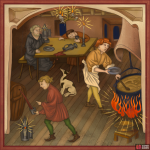Text
The main source of light after sunset in households was fireplaces and hearths. When that was insufficient, torches (flambeaux) were used to illuminate pathways or dwellings in the Middle Ages, along with lanterns, oil lamps and candles. Ceramic or metal oil lamps had a bowl shape, sometimes with a handle. A wick immersed in oil was used in these, and later, wax was added. In wealthier households, chandeliers were hung from the ceiling with chains. In villages, simple lamps burned tallow instead of vegetable oils, and split wood torches were used. Tallow candles were smelly, smoky, and melted quickly. They needed to be wiped, and the tallow collected for reuse, which is why they were placed in holders with a bowl.
In Central Europe, beeswax was considered an extraordinarily expensive commodity in the Middle Ages and was even used as a form of payment for guild fees (“payment in wax”).


No Comments